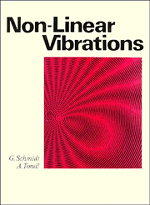Book contents
- Frontmatter
- Preface
- Contents
- Introduction
- 1 Basic properties and definitions
- 2 Methods of solution
- 3 Auxiliary curves for analysis of non-linear systems
- 4 Analysis in the phase plane
- 5 Forced, parametric and self-excited vibrations
- 6 Vibrations of systems with many degrees of freedom
- 7 Investigation of stability in the large
- 8 Analysis of some excited systems
- 9 Quenching of self-excited vibration
- 10 Vibration systems with narrow-band random excitation
- 11 Vibration systems with broad-band random excitation
- 12 Systems with autoparametric coupling
- Appendix
- Bibliography
- Index
3 - Auxiliary curves for analysis of non-linear systems
Published online by Cambridge University Press: 10 May 2010
- Frontmatter
- Preface
- Contents
- Introduction
- 1 Basic properties and definitions
- 2 Methods of solution
- 3 Auxiliary curves for analysis of non-linear systems
- 4 Analysis in the phase plane
- 5 Forced, parametric and self-excited vibrations
- 6 Vibrations of systems with many degrees of freedom
- 7 Investigation of stability in the large
- 8 Analysis of some excited systems
- 9 Quenching of self-excited vibration
- 10 Vibration systems with narrow-band random excitation
- 11 Vibration systems with broad-band random excitation
- 12 Systems with autoparametric coupling
- Appendix
- Bibliography
- Index
Summary
Characteristic features of auxiliary curves, particularly the backbone curves and the limit envelopes
In harmonically excited systems, especially in systems with one degree of freedom, the specific characteristics of the auxiliary curves have been found to be very useful for preliminary qualitative analyses of stationary vibration as well as for identification of the various elements (e.g. damping) of the system being examined on the basis of experimental results. In the former case they enable the analyst to make a prompt estimate of the basic properties of the system and of the effect of various parameters on its behaviour, in the latter, to identify the specific properties of the system and in turn to formulate a suitable analytic expression of the forces acting in a particular element for the purpose of a mathematical model.
Let us first consider the characteristics of the so-called backbone (or skeleton) curve, and of the curves connecting the points at which sin ϕ = const (ϕ is the phase angle between response and excitation). The limiting case of the latter curves (sin ϕ = ± 1; the minus sign has no meaning except in special cases stated farther on) is the so-called limit envelope (this term was proposed by Tondl (1973d)). The backbone curves have been used in routine analyses for a long time; the application of the second type of curves, the limit envelope and the sin ϕ = const curves, is less common.
- Type
- Chapter
- Information
- Non-linear Vibrations , pp. 48 - 76Publisher: Cambridge University PressPrint publication year: 1986



